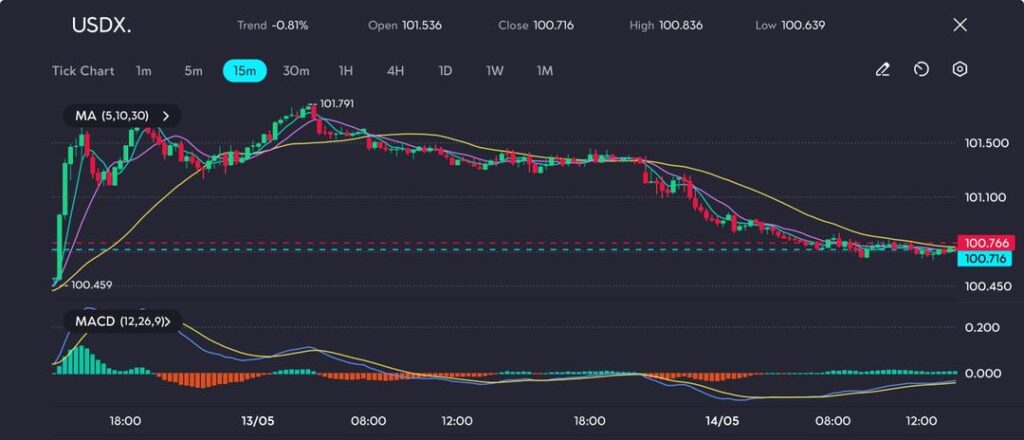
Key Points:
- Dollar Index (USDX) slipped 0.8% on Tuesday, its steepest fall in over three weeks.
- U.S. CPI rose just 0.2% in April, below the forecast of 0.3%, reinforcing expectations for Fed rate cuts.
The U.S. dollar pulled back sharply on Tuesday and steadied early Wednesday as softer-than-expected inflation data revived bets for Federal Reserve rate cuts later this year. The USDX index closed at 100.716 after plunging from Monday’s one-month peak of 101.791, tracking its worst daily performance since mid-April.
The move came after the Labor Department reported U.S. consumer prices increased just 0.2% month-on-month in April. That figure missed Reuters’ consensus forecast of 0.3%, offering fresh support to dovish market expectations. March had already printed a rare 0.1% decline.
However, inflation pressures could resurface, with tariffs potentially driving up costs in the coming months. President Trump’s trade team recently secured a 90-day tariff truce with China, but the next round of talks remains uncertain. Trump has also teased “potential deals” with India, Japan, and South Korea, but the lack of clear frameworks continues to unnerve markets.
Despite Tuesday’s drop, analysts at TD Securities and Commonwealth Bank of Australia anticipate further near-term strength in the greenback before a larger downtrend resumes. TD notes the dollar could lose as much as 5% in H2 2025 as global traders diversify away from U.S. assets amid ongoing policy unpredictability.
Technical Analysis
The US Dollar Index (USDX) broke above the 101.70 mark early on 13 May, but the rally was short-lived. After peaking at 101.79, the index began a consistent decline, slipping below the 10-, 20-, and 30-period moving averages and confirming a bearish crossover. This downtrend continued steadily into 14 May, with the price now hovering near 100.71, a level aligned with prior support at 100.45.

Picture: USDX tumbles from 101.79 peak, slips toward 100.70 as bearish pressure builds near key support, as seen on the VT Markets app
Momentum indicators further confirm the bearish bias. The MACD histogram remains negative, and the signal lines have diverged bearishly, indicating sustained selling pressure. Unless the bulls can reclaim the 101.00 threshold, the path of least resistance remains downward, with 100.45 and potentially 100.20 acting as next areas of interest.
Cautious Forecast
The dollar may experience a brief bounce as markets digest the CPI data and reassess global economic outlooks. However, the broader trend remains fragile, especially with Fed funds futures pricing in at least 50 bps of cuts this year. A sustained recovery in the USDX will likely require stronger economic data and more clarity around U.S. trade policy.









